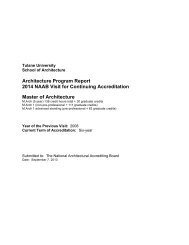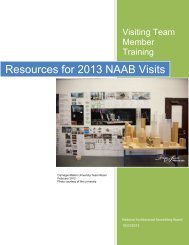Architecture Program Report Tulane University New Orleans ...
Architecture Program Report Tulane University New Orleans ...
Architecture Program Report Tulane University New Orleans ...
Create successful ePaper yourself
Turn your PDF publications into a flip-book with our unique Google optimized e-Paper software.
ability to employ appropriate representational media.<br />
Also in First-year, students are introduced to image manipulation and<br />
desktop publishing as part of their Design Studio requirement—this<br />
component is included in the representational skills courses (graduate<br />
students receive additional instruction in InDesign, Photoshop and<br />
Illustrator and other applications as part of the Summer <strong>Program</strong>). This<br />
encourages not only graphic design skills development, but also the<br />
maintenance of their portfolios.<br />
The required courses are supplemented by additional courses that include<br />
digital technologies skills across the curriculum, under the headings of<br />
ADGM and AVSM courses. For instance, ADGM 310 (Digital Media II: CAD<br />
and Spatial Modeling) is required as a co-requisite with first semester<br />
second year design (DSGN 210). While for the most part the ADGM<br />
courses are required, the AVSM courses are offered as electives, thereby<br />
supplementing students’ graphic skills.<br />
Perhaps the single most critical factor in the acquisition and development<br />
of representational media techniques is “peer-to-peer” instruction whereby<br />
many students become exceptionally adept with computer graphics<br />
techniques and applications. This is a natural outcome of the studio<br />
environment and is actively encouraged by the faculty.<br />
It should also be noted that the design faculty are, in general, interested in<br />
the critical apprehension of representational media and that many, if not all,<br />
have some familiarity with computer programs that support various<br />
representational media.<br />
4. Research Skills<br />
Ability to gather, assess, record, and apply relevant information in<br />
architectural coursework.<br />
The development of the student’s ability to employ basic methods of data<br />
collection and analysis pertinent to all aspects of the programming and<br />
design process is diffused throughout the Design Studio (DSGN)<br />
curriculum. Both analytical and empirical methods of data collection are<br />
encouraged, and the students are introduced to the methods of analysis<br />
associated with the evaluation of collected data. In the School of<br />
<strong>Architecture</strong>, the subject of data collection is discussed under the rubric of<br />
“architecture as research.” This idea reflects not only the traditional<br />
scientific and academic methods—empirical, critical, fact-gathering,<br />
abstract and quantitative research—but the fact that the design of<br />
architecture constitutes a kind of data collection based on the critical<br />
evaluation and analysis at all stages of the design process.<br />
In terms of programming, students are introduced to the methods of program<br />
evaluation in the core design studios (DSGN 110, 120; DSGN 210, 220). In<br />
particular, they are asked to not only respect the program in terms of use and<br />
to evaluate the internal relationships between the areas of programmatic use<br />
(function), but to establish a “a program for the program,” that is, an<br />
underlying conceptual strategy that will enable the building to function as<br />
architecture. The relationship between these two areas of function is critical














